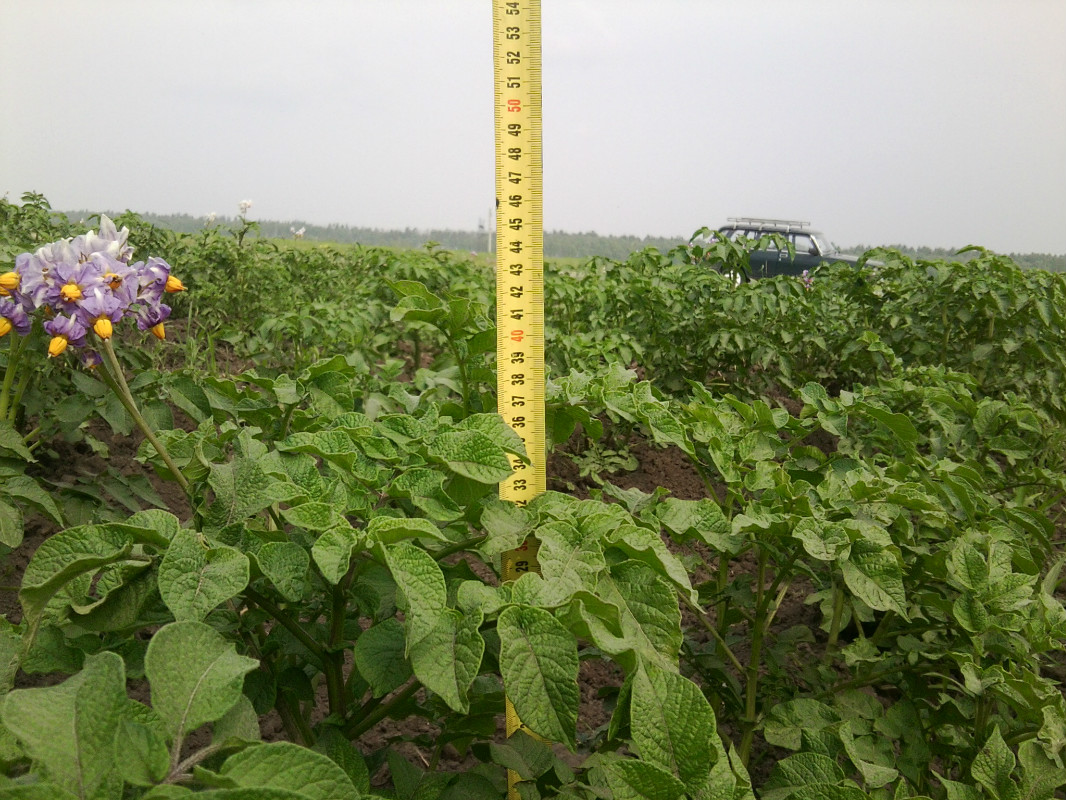
A good variety of potatoes and, carried out during the vegetable growing season, agricultural practices contribute to the growth of powerful high tops. However, if the growth of the apical part of the potato passes the mark of 120 cm, then you should worry. Indeed, in this case, the tubers will be very small, since the plant spends all its strength on the growth of the vegetative mass. Each potato variety is distinguished by individual characteristics. However, its vegetative mass should not exceed 125 cm.
Content
Reasons Why Potatoes Have High Tops
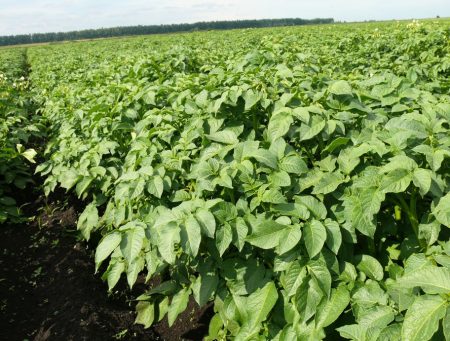
The reasons for the growth of leaves are influenced by several factors. Most often, they consist in the incorrect cultivation of potatoes.
Excess Nitrogen
When growing potatoes, you should adhere to the norms and intervals between top dressing with nitrogen-containing substances. Often noticing the weak growth of potatoes, several more top dressings are made with nitrate, urea, or mullein infusion. As a result, the vegetative mass begins enhanced growth to the detriment of the tuber pouring. In addition, a high nitrate content is accumulated in the soil.
Bushes with an overdose of soil with nitrogen have a powerful high stem, rich green tops. The vegetation period of the plant is delayed, flowering is delayed, and the susceptibility of potatoes to infection by infectious diseases increases. Therefore, nitrogen nutrition should be carried out strictly according to the instructions. It’s better not to feed the plants a bit than to feed them.
Excess moisture
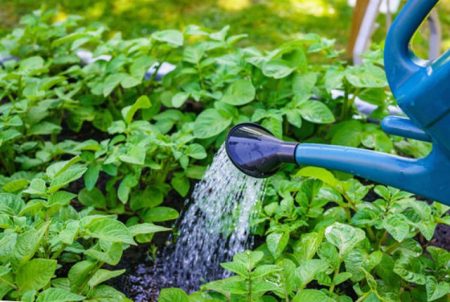
Potato is a water-loving plant, however, the saturation of the soil with water contributes to an acute shortage of air for tubers. In conditions of frequent rains, tubers cease to receive nutrients from the soil, so all the strength of the plant is directed towards the active growth of the vegetative mass.
Lack of light
If the potato beds are close to buildings, trees and tall plants, the apical part of the plants will also stretch upward. The bushes, receiving an insufficient amount of ultraviolet radiation, give all the strength to the tops to search for it. Potato is a light-loving plant, and with a lack of sunshine, it will certainly stretch the tops.
At the beginning of pulling the tops, potatoes should be treated with the chemical inhibitor Athlete. The tool will stop the growth of vegetative mass, will provide an opportunity for the accumulation of nutrients in tubers. However, after processing, potatoes will not be eaten for 28 days.
What to do if the tops are high
After making sure that a very high vegetative mass is not a feature of the variety, with the elongated tops, the following methods should be taken.
- If during the growth of the high vegetative mass of the potato is not cut, then all the useful trace elements obtained by the plant from the soil will simply disappear. The natural process of photosynthesis is disrupted, and the tubers still will not gain a good mass. Therefore, when stretching the tops above 120 cm, the tops should be bent to the ground, slightly trampled. Gradually, as the micronutrients and vitamins dry out, they will pass into the tubers, and they will gain a normal mass.
- An agronomic technique for increasing the productivity of overgrown potato bushes is spraying the vegetative mass two to three weeks before harvesting with complex fertilizers from 25% superphosphate 10% potassium to 10 liters of water. Five to six days before excavation, the apical parts should be beveled. Carrying out this technique accelerates the aging of tops, the outflow of nutrients from it into tubers, and their rapid maturation. After the intake of aging, the vegetable yield increases by 15% -20%.
- If the apical parts of the potato are pulled out due to an excess of nitrogen, it is worth putting mulch from sawdust into the basal part. Microorganisms that process this material require a large amount of nitrogen to develop. Therefore, wood sawdust 6-7 days after laying on the surface of the soil, all nitrogen will be drawn.
- With prolonged rains and drawing out the tops, you can treat overgrown plants with infusion of wood ash based on: 5 liters of water 1 glass of substance.
What to do if the tops are low
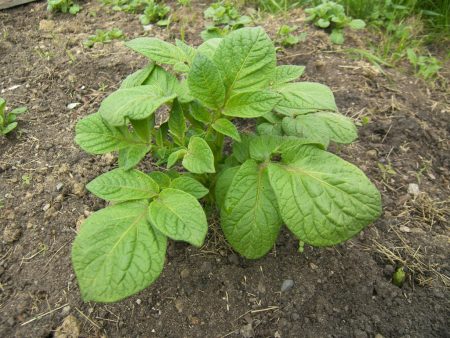
According to the state of potato tops, one can say about the well-being of the whole plant. So, if the vegetative mass of potatoes is low, then it is caused by:
- the presence of pathogenic fungi in the soil;
- lack of nutrients;
- illiterate fertilization and irrigation;
- dry weather and lack of moisture;
- pest insect attack.
With low growth of potato bushes due to lack of moisture, plants should simply be saturated with moisture. If the reason for the low tops is the lack of nutrition, then foliar fertilizing of plants with complex mineral fertilizer should be carried out twice, based on: for 10 liters of water - 20 g of urea, 20 g of potassium and 25 g of superphosphate.
To protect potatoes from damage by pathogens and insect pests that prevent the vegetative mass from developing normally, prophylactic treatments with fungicides and insecticides should be carried out throughout the growing season.
Prevention
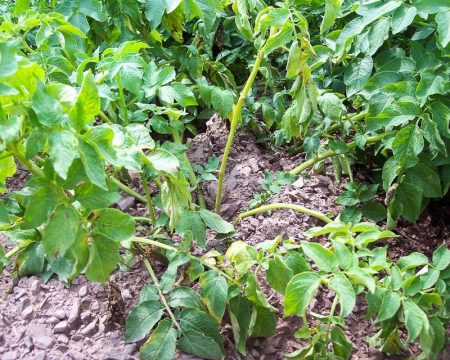
To prevent problems with elongated tops, it is necessary to carry out preventive measures, which include:
- in the autumn application of mineral fertilizers for digging the soil at the rate of: per 1 acre - 3 kg of superphosphate, 3 kg of potassium chloride, 3 kg of nitrate;
- in the treatment of tubers before planting with an extract from wood ash, based on: for 5 l of water - 1, 5 cups of ash;
- in the use of nitrogen-containing fertilizers only at the initial stage of potato growth;
- in planting potatoes only in sunny areas without the slightest shadowing;
- in compliance with the distance when planting tubers, which should not exceed 60 cm by 60 cm.
Advice
Adhering to the recommendations of experienced gardeners who have been growing potatoes for more than a year, it is possible to prevent the overgrowing of the vegetative mass and to get a decent potato crop.
- When cultivating potatoes in the southern regions, the plant calmly withstands partial shade. Therefore, in these areas it can be planted even under the canopy of trees. And, despite the elongated tops, the potato crop will be good.
- Carrying out timely hilling of bushes with soil, plants are provided with the best conditions for growth. At the same time, the yield of tubers increases by 10%.
- Having mulched potato ridges with a layer of organics of 20 cm-30 cm, you can save moisture in the soil, saturate the plants with microelements that are necessary for the development of tubers.

Do not be upset at the sight of an elongated tops. After all, taking appropriate measures on time, the gardener will get a good harvest of tubers.




 Description and description of varieties in Belarus with a photo
Description and description of varieties in Belarus with a photo Do I need to pick flowers from potatoes: why do they do it
Do I need to pick flowers from potatoes: why do they do it When to dig potatoes: timing and availability of new potatoes
When to dig potatoes: timing and availability of new potatoes How to grow a good potato crop: various methods and methods, planting and care
How to grow a good potato crop: various methods and methods, planting and care